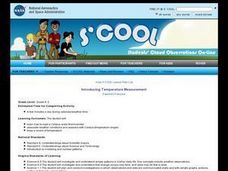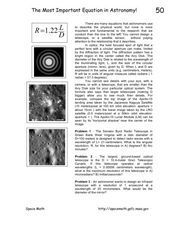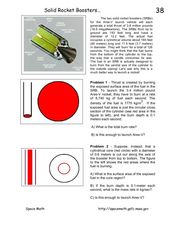Curated OER
Poetry in Weather
Students identify clouds outdoors using a cloud chart and then draw the types they observe. They read the poem, "Fog" by Carl Sandburg and then compose their own cloud poem using various styles of poetry.
Curated OER
Alka-Seltzer Rockets: How to Build Your Own Rocket
Students create a rocket using Alka-seltzer of baking soda and vinegar. In this physics lesson, students identify the factors affecting the length of time the rocket is propelled. They relate this activity to actual rocket launched in...
Curated OER
How Does Flowing Water Shape a Planet's Surface?
Students investigate how flowing water influence landforms. In this earth science lesson, students observe water behavior as it flows from the stream table at various inclinations. They discuss whether water shaped Mars landforms or not.
Curated OER
Exploring Ultraviolet (UV) Light From the Sun
Students identify the different energy given off by the sun. In this earth science lesson plan, students predict where the UV beads will turn the darkest color. They explain the importance of using UV protection.
Curated OER
Weather Art in Space Settlements
Students demonstrate a cloud formation and the relation between pressure and temperature in gases. They explain how clouds could be created in space settlements and see the relation between pressure and temperature in gases.
Curated OER
Make Your Own "Weather" Map
Students develop and apply a variety of strategies to solve problems, with an emphasis on multi-step and non-routine problems. They acquire confidence in using mathematics meaningfully.
Curated OER
Newton and his Laws
High schoolers explore Newton's laws, including what they state, and what the intuitive meaning is of the first and third laws.
Curated OER
The Sky and the Dichotomous Key
Students use a dichotomous key to distinguish between different types of clouds
Curated OER
Planet-Tac-Toe Review Game
Students research the nine planets in the solar system. They play a board gram like tic-tac-toe using the names of the planets. Factual info is given to help play the game.. This sounds like a fun review game.
Curated OER
Sunrise, Sunset: Apparent Motion of the Sun
Students discuss the meaning of a day and what happens to the sun as it turns to night. Then they go outside and draw the view in front of them, paying close attention to the location of the sun. Every hour they return and chart the...
Curated OER
Introducing Temperature Measurement
Students explore temperature and use Celcius thermometers to measure and graph the temperature in the classroom daily. They estimate what they think the temperature might be and then find the actual temperature in the room.
Curated OER
Identifying Clouds
Students work in groups to research and prepare a report on cloud types. They present their findings to the class and take a group quiz competing for points. Students go outside and determine which type of clouds are visible on that day.
Curated OER
Human Needs
Pupils investigate human needs and how they have adapted to different environments. They complete an experiment to discover the effect of stress on muscles. They use the food pyramid to create a plan for healthy eating.
Curated OER
Hydroponics
Students discuss the concept of hydroponics. They create and run their own hydroponics system. They record and analyze the data they collect.
Curated OER
Circular Motion: Target Practice
Students demonstrate direction of velocity of an object in circular motion. They discuss the mathematical formula, and demonstrate the formula using a string, rubber stopper and a target.
Curated OER
The Most Important Equation in Astronomy!
In this astronomy optics learning exercise, students calculate the angular resolution and maximum resolution for given telescope specifics. This learning exercise has 3 problems to solve.
Curated OER
Solid Rocket Boosters
For this rocket worksheet, students calculate the burn rate for solid rocket boosters depending on exposed fuel area and burn depth. This worksheet has 2 problems to solve.
Curated OER
Carbon Footprint Estimator
Students discover what a Carbon Footprint represents. In this sustainable lifestyle lesson plan, students determine their Carbon Footprint as an individual and as a class. Students use a the Internet to calculate how many earths it would...
Curated OER
Jet Engine Magazine
Students explore physics by creating a magazine cover in class. In this flight instructional activity, students identify the motion and force that must be generated in order for a jet engine to lift off the ground. Students create a...
Micron Technology Foundation
Forces of Motion: Rockets
Young scientists design a rocket to launch using Newton's Laws of Motion in order to discover for themselves the forces of motion.
National Wildlife Federation
The Tide is High, but I’m Holding On… Using ICESat Data to Investigate Sea Level Rise
Based on the rate of melting observed from 2003-2007 in Greenland, it would take less than 10 minutes to fill the Dallas Cowboys' Stadium. The 17th activity in a series of 21 has scholars use the ICESat data to understand the ice mass...
Curated OER
Aerospace Engineering
Twelfth graders examine the physics of rocket flight. They build and launch model rockets to measure their performances.
California Academy of Science
Kinesthetic Astronomy: The Meaning of a Year
How many times have you traveled around the sun? Aspiring astronomers grasp what a year is and they differentiate between orbit and rotation by walking around the sun right within your classroom. Place a lamp in the center of the room to...
California Academy of Science
Kinesthetic Astronomy: Mars Opposition Dance
Your class will watch as one child orbits the sun as Earth, while another orbits as Mars. If the timing is right, they will see the repetitive dance between the two planets and discover how often they are opposite from each other. For...

























